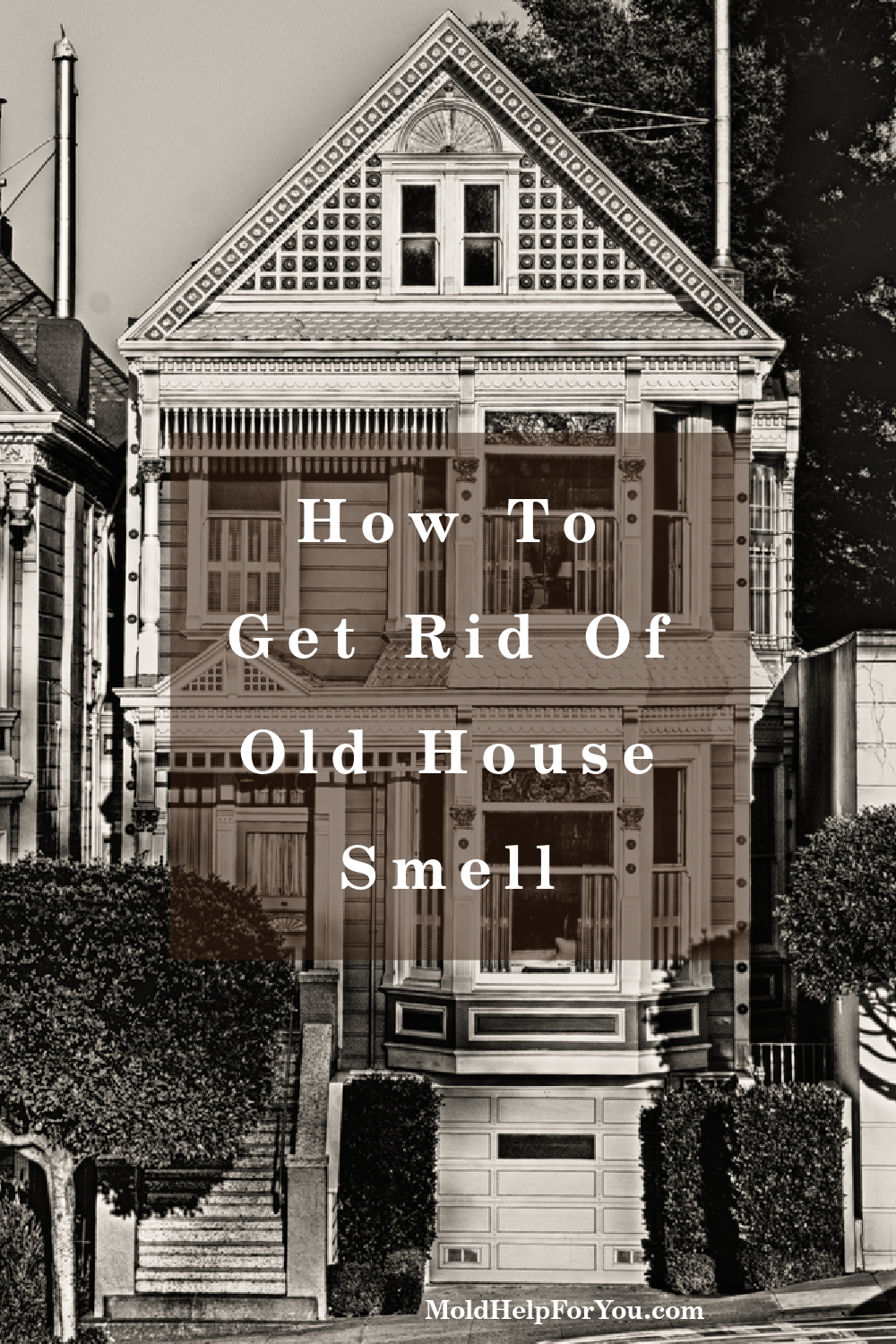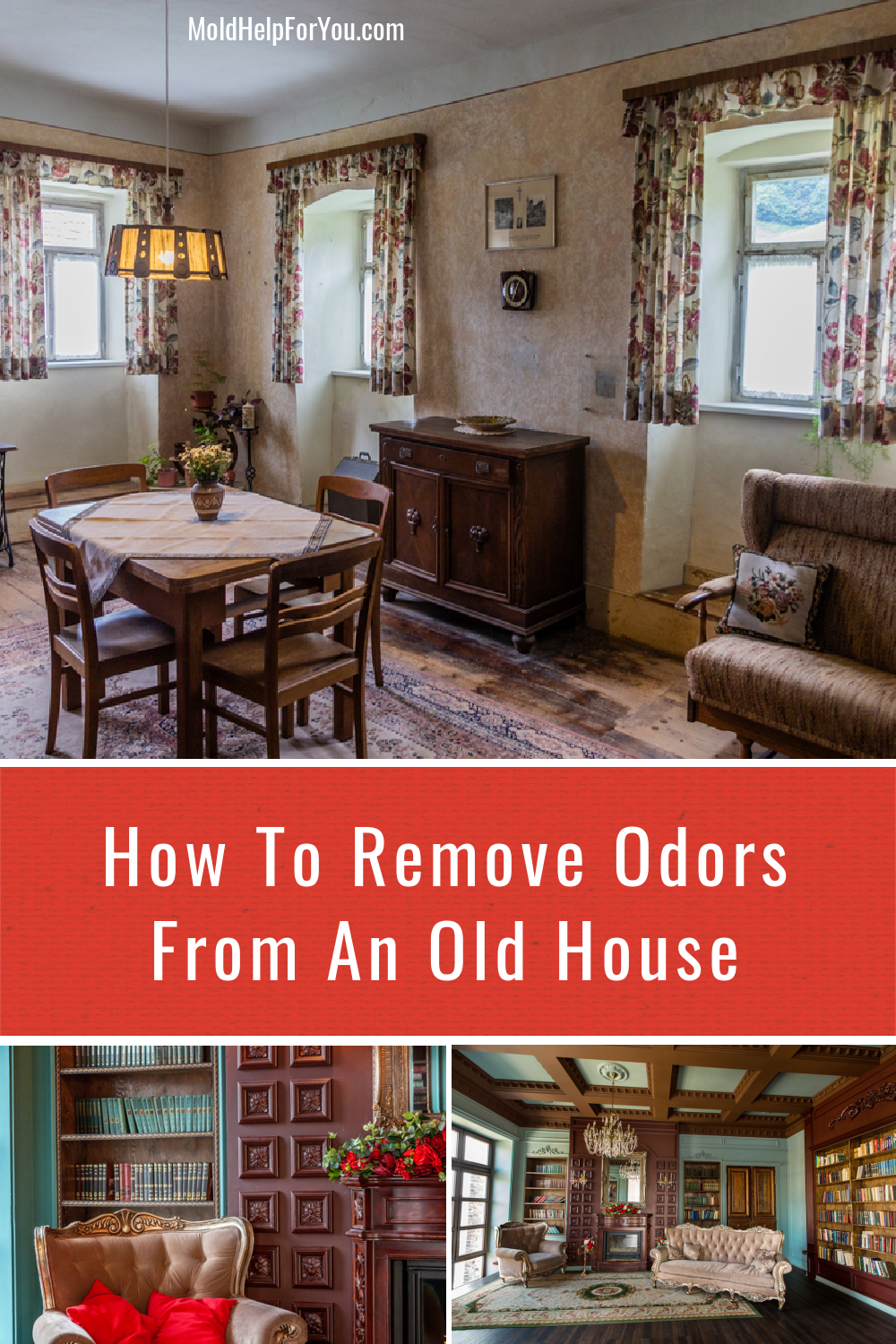How To Get Rid Of Old House Smell
This post may contain affiliate links. Read our full disclosure.
Three little words – Old House Smell. Instantly you knew exactly what that is. Or do you?
I think we can all agree that this is not a pleasant odor and it certainly is one that no one really wants in their home. But what actually causes old house smell and how can you get rid of it?
What Is Old House Smell?
Old house smell is that cross between musty and sour with a side dish of “something is off.” Like I said above, when you smell it you know exactly what it is.
The majority of the time, old house smell is found in old houses. (I know, weird. Ha). A house built between 1880 and 1980 has had a lot of living happen in it. So there are bound to be some odors. However, new homes can even develop an old house smell given the right conditions.

What Causes Old House Smell?
Finding the source of a smell can prove difficult at times. This is often the case with old house smell. If the house is actually old, a lot of investigation may need to take place to locate the source of the offending odor.
Here are the top 12 causes of old house smell:
- Mold – Mold is the number one cause of old house smell without question. This has to do with a little something called microbial volatile organic compounds (mVOCs). When mold, bacteria, biofilm, and other biological growths decay, they emit mVOCs — the gases we identify as old house smell. Mold can actually smell like a lot of things so don’t assume it only smells like an old home.
- Water leaks and/or high humidity – moisture in and of itself doesn’t cause an old house smell. However moisture and high humidity are precursors to mold which does cause old house smell. Mold also likes dark areas where water can accumulate like under sinks, in basements, and in attics.
- HVAC system – If you haven’t cleaned your ducts recently, they are likely dirty and dusty, resulting in a musty odor. In addition to your ducts, your heating and cooling equipment itself may be introducing musty odors.
- Stale air – ever come back from an extended time away from home only to smell that old house funk? That’s because while you were gone there was no air movement. Regular opening and closing of doors and windows, moving between rooms, running the HVAC, and the like actually helps prevent household odors from going stagnant. Houses need to breath and that stale air smell occurs when air flow has been limited.
- Pets – let’s face it. Pets of all kinds stink to one degree or another. Whether it is that old wet dog smell, the distinct litterbox odor, the fish tank that needs cleaning, or the neglected pet beds, pets create all kinds of odors. The most common pet related old house smell is urine that has soaked into carpet, flooring, and baseboards.
- Critters and Pests – does your house smell like stale popcorn? You’ve got mice. Have more of an oily, musky odor? You’ve got cockroaches. Although these are not traditional old house smell descriptions, they are indeed causes of unexplained smells in your house. It might also be the case that you have a dead critter in a wall, attic, or under a crawlspace.
- Cigarettes or Cigars – Residual tobacco smoke (third hand smoke) contamination lingers in rooms long after the cigarette or cigar is gone. Nicotine, a toxic particle, can cling to walls and ceilings, while gases can be absorbed by soft fabrics such as upholstery and carpet. One study from 2002 discovered that those gases can be re-emitted into the air and recombine to form harmful compounds that “remain at high levels long after smoking has stopped occurring.” Although the distinct cigarette or cigar smoke smell may be gone, these compounds linger adding to that old house smell.
- Carpet and Wallpaper – These items retain odors of all kinds and from all sources. Carpet is one of the worst offenders for holding in that old house smell. But drapery and wallpaper are a close second.
- Drains – Dirty drains are a hot spot for bacteria and mold that cause old house smell. To clean your drains, pour a cup of baking soda down the drain, followed by a cup of vinegar. After half an hour, rinse the drain with hot water. If the smell remains, it may be related to a sewer problem. In this case, you’ll need to call a professional.
- Houseplants – While there are some strong arguments for having houseplants, houseplants can also cause many issues. Old house smell is actually one of them. This musty odor that is coming from your houseplants is likely due to over watering. When plants are given more water than they need, the result can lead to mold or fungus growth, or even root rot. If you want to keep those houseplants, be sure to read my article on preventing mold in houseplant soil.
- Exposed dirt floor in crawlspace – If you have dirt earth in the crawlspace, it could make the house smell musty after rain, or earthy during hot, humid weather.
- Old people – Wait what? Actual old people? Hear me out please. If you recently moved into a home that was previously occupied by seniors, you could very well literally be smelling them. This has to do with a chemical known as 2-nonenal. This chemical is naturally produced as the body sweats, but only when we get older. It’s that distinct old people smell and it may very well have gotten trapped in the house.
How To Get Rid Of Old House Smell
First and foremost you need to make sure that you do not have a large scale or house wide mold issue in play. Mold testing is the first step. Depending on those results, a full-blown mold inspection may be in order. After that, mold remediation may need to take place.
Barring a mold issue, there are several ways to tackle “operation old house smell removal.” Some methods are specific to the source of the odor (which obviously you should find) and other options will assist in removing the old house smell no matter what the cause.
Air out the house
Remember the discussion about stale air above? Homes need to have air circulating and one of the best ways to do this is to open the windows! While it won’t tackle the source of the odor if the source requires removal, it will assist in getting all those lingering odors moved out from inside your home.
HVAC and Ductwork
Have your HVAC serviced and your duct work cleaned. Make sure to change your air filters regularly.
Remove carpet, drapery, and old wallpaper
Since these building materials are the worst offenders at holding onto old house smell, they need to be the first to go. Unfortunately removing carpet, drapery, and wallpaper won’t always get rid of the odor 100%. You will want to be sure to use this subfloor treatment after you remove the carpet and carpet pad. After removing wallpaper, you will want to clean the walls with Superstratum, Remedy, or EC3.
Have older real wood floors professionally stripped and resealed
Odors can build up on older wood floors. Over time the finish wears off and the wood becomes exposed. Wood easily absorbs odors from whatever gets on it which can then release that old house smell into the air. There is a chance that the odor causing agent seeped underneath the wood floors so make sure you have your floors inspected thoroughly before stripping and resealing them.
Seal exposed dirt floors in crawlspace.
This is definitely something to leave to the professionals. Every crawlspace is different. If you have mold or moisture in your crawlspace already, that requires remediation first.
Use a dehumidifier to keep humidity levels in check.
Mold loves moisture and high humidity won’t do you any favors in the old house smell department. Running a dehumidifier if you live in a humid area or have a basement is critical. You can read more on dehumidifies in this article.
Use an air purifier in your main living space and bedrooms.
Air purifiers are designed to pull all kinds of nasty stuff out of the air you breathe. It helps with odors by removing those things that cause odors. You can read more on air purifiers in this article as you want to make sure you are choosing the right air purifier for your situation.
Clean your couch and other fabric furniture.
Body fluids, food and beverages, pet debris, dust, and other household nasties lurk in couches and fabric furniture. While weekly vacuuming is a great idea, twice yearly deep cleaning is a must. I highly recommend HavenClean Carpet and Furniture Treatment since it tackles mold spores.
Let sunlight in.
Sunlight has an ultraviolet component that is nature’s best disinfectant.
Pet hygiene
If you have pets, make sure you wash their bedding often, clean up potty accidents promptly using my favorite product Bubba’s, scoop litter boxes daily and wash them out every two weeks, cover furniture with water resistant blankets and wash these weekly, and vacuum the floors often. If you have a pet that tolerates baths, bathe them regularly with this pet shampoo. It is designed specifically to “bio balance” your pet’s skin and fur.

I’ve tried everything but there is still a lingering old house smell that just won’t go away! What can I use to absorb odors?
Citrus – Boil a piece of orange or lemon in a pan of water for about 60 minutes to absorb odors and release a fresh scent.
Vinegar – Setting out a bowl of white vinegar can be a great way to help absorb unpleasant odors from kitchens, closets, refrigerators, and other areas of your home.
Activated Charcoal – Activated charcoal does wonders for household odors by physically pulling them out of the air on a microscopic level. These air purifying bags are made from sustainable, eco-friendly bamboo charcoal, contained in sturdy cloth bags with a reinforced hole for hanging them up around the house. In my experience they work best in smaller spaces like closets, in cabinets, and under sinks.
Baking Soda – Baking soda works best on items that are fabric based. Sprinkling it on carpet, rugs, fabric couches, etc… and letting it sit overnight can help remove odors. Vacuum it up after 12 hours for a fresher living space. You can also set out boxes of opened baking soda to absorb odors.
Kitty Litter – Kitty litter is designed to absorb that distinctive cat pee smell. While I wouldn’t go around sprinkling cat litter everywhere to absorb odors, it does work quite well to absorb odors from things like rugs, garbage cans, shoes, and other items that are difficult to wash. To use kitty clean to remove odors, fill a study garbage bag with 2 pounds of litter, add the item, tie it up tight, and let it sit for a week. Remove the item and clean it off and that offending odor should be gone. For garbage cans, simply add a layer of kitty litter to the bottom of the can. I recommend Tidy Cats Non Clumping litter.
How To Prevent Old House Odors From Returning
You’ve put time, energy, and money into kicking those old house smells to the curb. But what’s the secret to keeping them away?
Mold prevention, home maintenance, and overall good cleaning practices. A house is like a body. Neglect it and there are going to be issues. Take care of it and it should operate rather well for many years.
